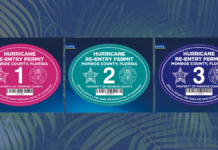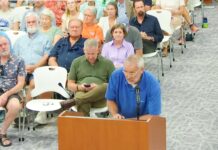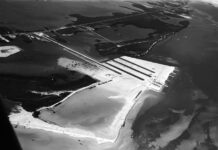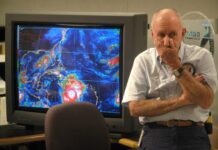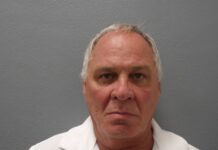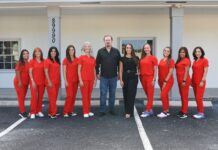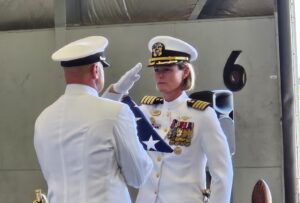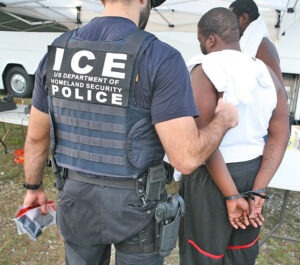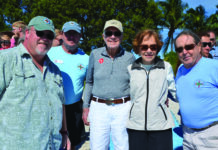If you have ever purchased a pair of one of the Southernmost City’s premier cultural contributions, Kino sandals, you have been within a coconut’s throw of Fitzpatrick Street. The same could be said if you had ever had a cold beverage at Capt. Tony’s Saloon, though it would take a stronger throw. Richard Fitzpatrick is the street’s namesake. Born circa 1792 to a wealthy plantation family in Columbia, South Carolina, Fitzpatrick was one of Key West’s early, early residents. By the time he arrived circa 1822, he was working as a lawyer.
In Key West, in addition to his law practice, he served as the island’s auctioneer when it came time to sell off, among other things, cargoes salvaged during wrecking operations. In 1830, he entered the salt game — a valuable commodity. Fitzpatrick leased 100 or so acres on the southeastern side of the island from William Whitehead. The land was subject to saltwater intrusion and the perfect place to create salt ponds.
He developed his operation by dividing the land into individual pools measuring 100 feet long and 50 feet wide. Each pool, or pen, was corralled by two-foot-tall rock walls. Wooden flood-gates interconnected each pen, and when they opened, each flooded. When the gates were closed, the water was trapped, and evaporation became its only escape. When the water was all gone, salt crystals remained. Those measuring one-eighth to one-quarter of an inch in size were harvested for sale.
Salt baron, auctioneer and lawyer were not his only titles. Following in his father’s footsteps, Fitzpatrick also worked to become a plantation owner. On Dec. 1, 1830, he purchased a Miami River homestead for $400. Before he was done, he would own four square miles along the Miami River and one square mile around the New River (Fort Lauderdale). In 1830, he also threw his hat into the political ring and was elected to represent Monroe County as its state senator in the Territorial Council for the 1830-1832 congressional sessions.
It was during this term that a bill was introduced to create the North American Salt Company. Not only would it be established in Key West, but it would compete with Fitzpatrick’s own production company. Fortunately, he held a position of power and argued against the idea in front of the men elected to vote. The vote against the formation of the North American Salt Company fell in favor of Fitzpatrick. His salt ponds remained the only significant active source of salt produced on the island.
He was elected to a second term to represent the best interests of the people of Monroe County as a state representative in the Territorial Council. During the 1835-1836 session, Fitzpatrick was elected president of the Legislative Council. In the early days of January 1836, Fitzpatrick presented a bill that, when it passed, was going to blow the good people of Key West away.
The bill proposed the creation of Pinckney County. It was accompanied by a supporting petition signed by 133 residents of the three major territorial communities outside of Key West, Indian Key, Key Vaca, and Cape Florida, as well as those outposts that had been established along the Miami and New rivers.
One argument in favor of the bill involved the civic obligation of jury duty. Because Key West was the county’s most populous city, it served as the county seat and, therefore, the center around which all government affairs would travel. The court system, for instance, was located in Key West. When the county’s citizens were called for jury duty twice yearly, they were summoned to Key West. One of the reasons the bill passed was that it was determined that traveling to Key West was too big a burden for those living in Monroe County’s northern settlements.
The bill passed in no small part due to Fitzpatrick’s efforts. However, by the time it was officially approved, on Jan. 28, 1836, the new county’s name had been changed to honor Major Francis L. Dade, killed weeks prior in an exchange sometimes identified as the spark igniting the second escalation of the Seminole War.
The new Dade County started north of Bahia Honda and stretched to Lake Okeechobee. With a new county, a new county seat was needed. Because Indian Key was the largest community in Monroe County not named Key West, and the largest in the newly formed Dade County, it was declared the county seat. Court proceedings, however, would not be solely limited to Indian Key. At least once a year, the county court would be scheduled to convene at the Cape Florida community on Key Biscayne.
As a last note, the jury duty argument presented by Fitzpatrick in 1836 still resonates. As an Upper Keys resident, being called to jury duty in Key West is still inconvenient, and now there are cars and the Overseas Highway, and the trip is only two hours, more or less, each way.

